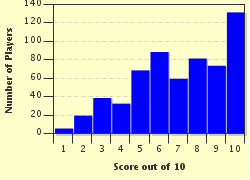Quiz Answer Key and Fun Facts
1. Tokyo, formerly called Edo, started as a small fishing village named Hirakawa-mura. It wasn't until the 12th century that Hirakawa-mura began to spring up when Edo Shigenga built his home there. That home was later expanded by Ôta Dôkan and became what famous building?
2. By the early 17th century, Edo (the former name of Tokyo) was quickly becoming the most powerful city in Japan, rivaling that of the official capital, Kyoto. What is the name of the man who achieved this feat? He was also the first Tokugawa shogun.
3. The Tokugawa shoguns ruled Edo (the former name of Tokyo) and Japan for over 264 years. During that time the city saw great improvements including the establishment of several schools which are now Tokyo University. It also saw its fair share of tragedies. Which of the following is not a catastrophic event that blighted Tokyo during the Tokugawa shogunate?
4. In 1867, after years of political tension between the Tokugawa shoguns and the emperors, Tokugawa Yoshinobu resigned, giving control of Edo (the former name of Tokyo) and Japan to the emperors. What is the main reason the shift in power was seen as necessary by the Japanese people?
5. When Emperor Meiji arrived in Edo in 1868, he renamed the city Tokyo, which means what in English?
6. An earthquake struck Tokyo in 1923, called the Great Kanto Earthquake. About 3% of the city's population was killed and fires destroyed or damaged nearly every building. An estimated 10,000 people of what group were killed in the aftermath of the quake?
7. Citizens of Tokyo generally enjoyed many freedoms and liberties that were limited in Japan outside of the city. This changed during World War II when these freedoms were set aside to maintain the peace and control. Tokyo was also the first Japanese city to be bombed during World War II on April 18, 1942. What was this bombing called?
8. Which famous American general led the recovery effort of Japan after World War II from Tokyo?
9. In the 1980s, Tokyo's economy and population boomed creating a need for more buildings and homes within a short period of time. How was this problem solved?
10. On September 7, 2013, Tokyo was selected to host what for the third time? (It will, however, be the second time it hosts.)
Source: Author
Joepetz
This quiz was reviewed by FunTrivia editor
bloomsby before going online.
Any errors found in FunTrivia content are routinely corrected through our feedback system.

